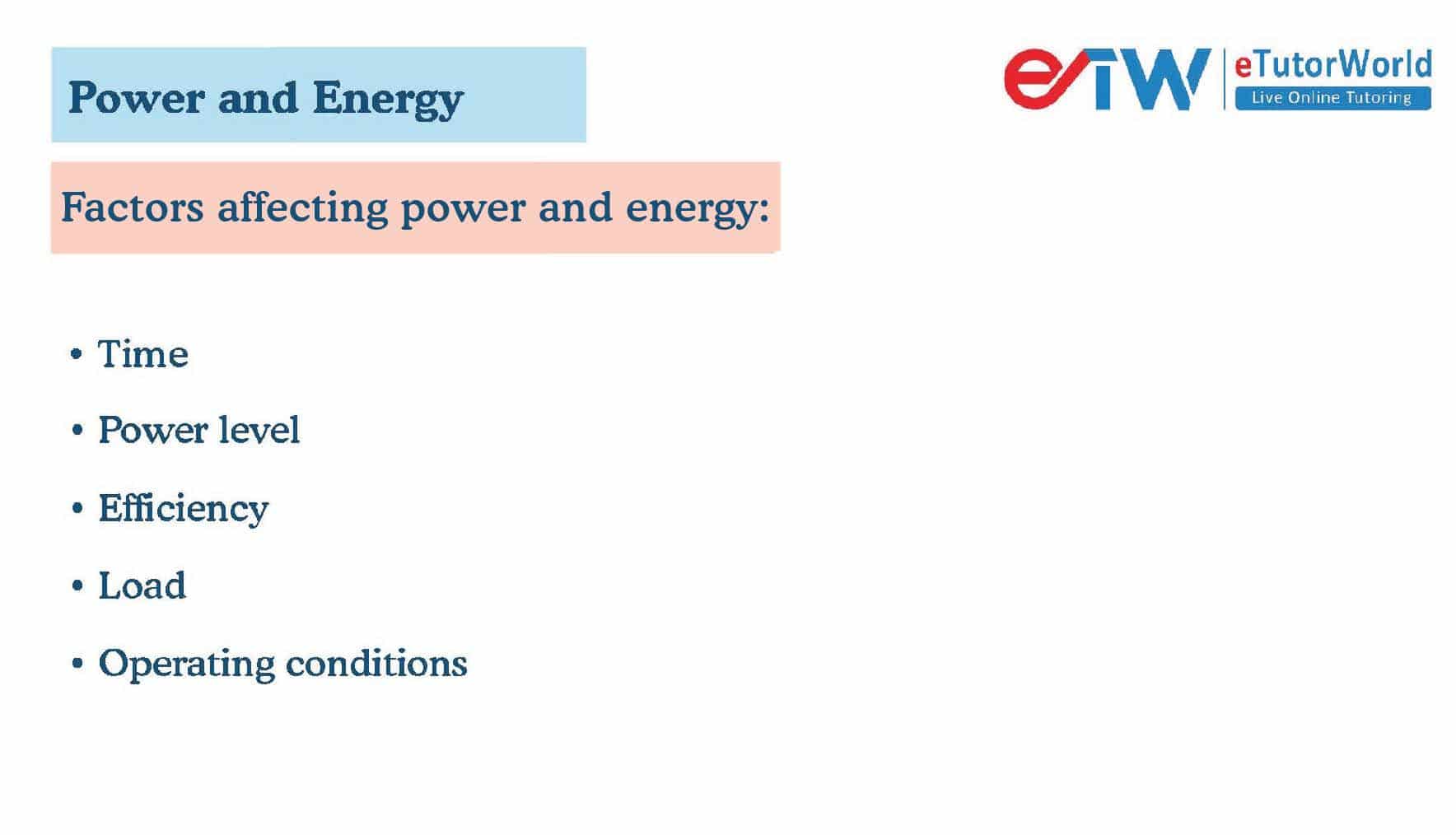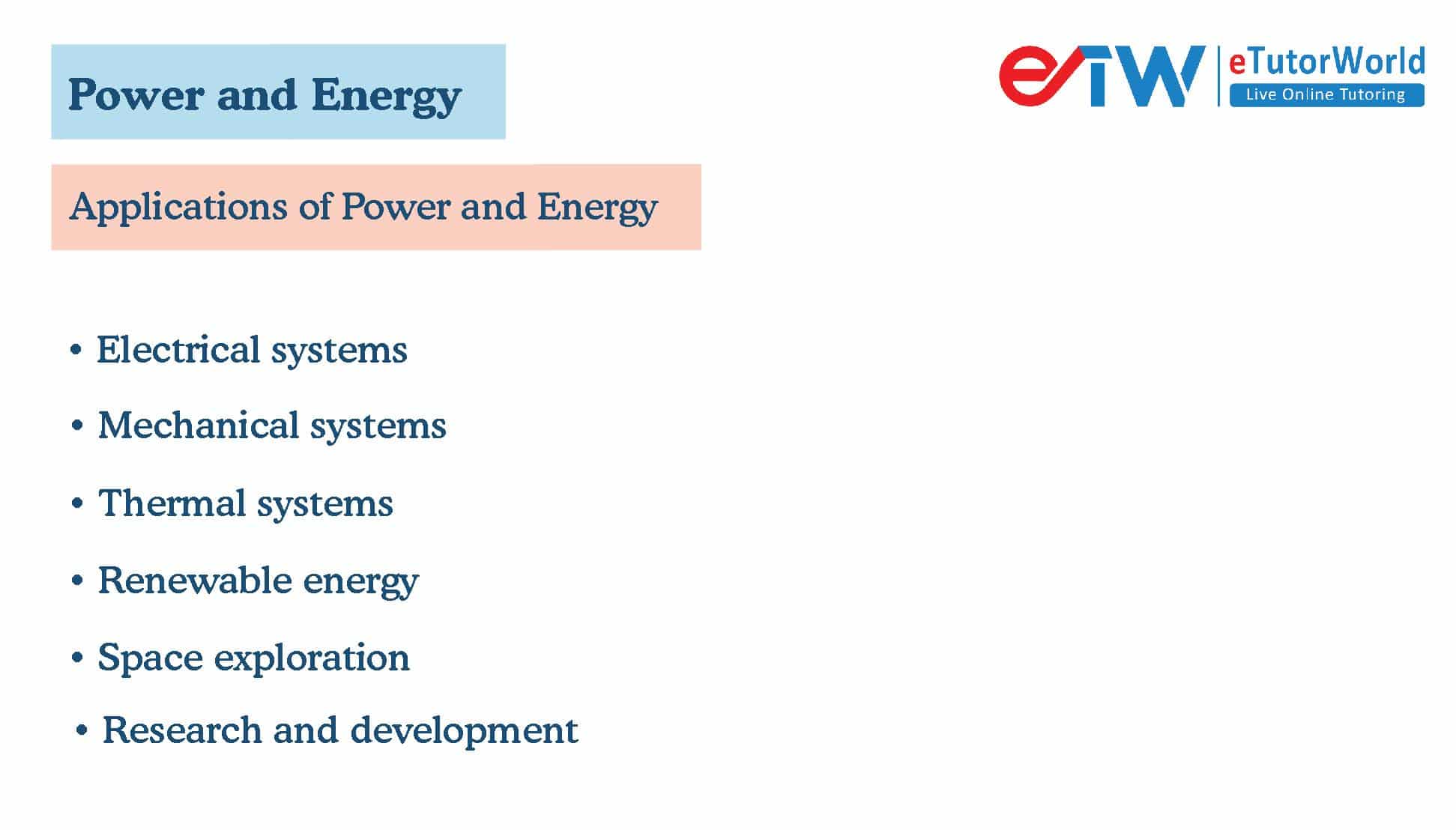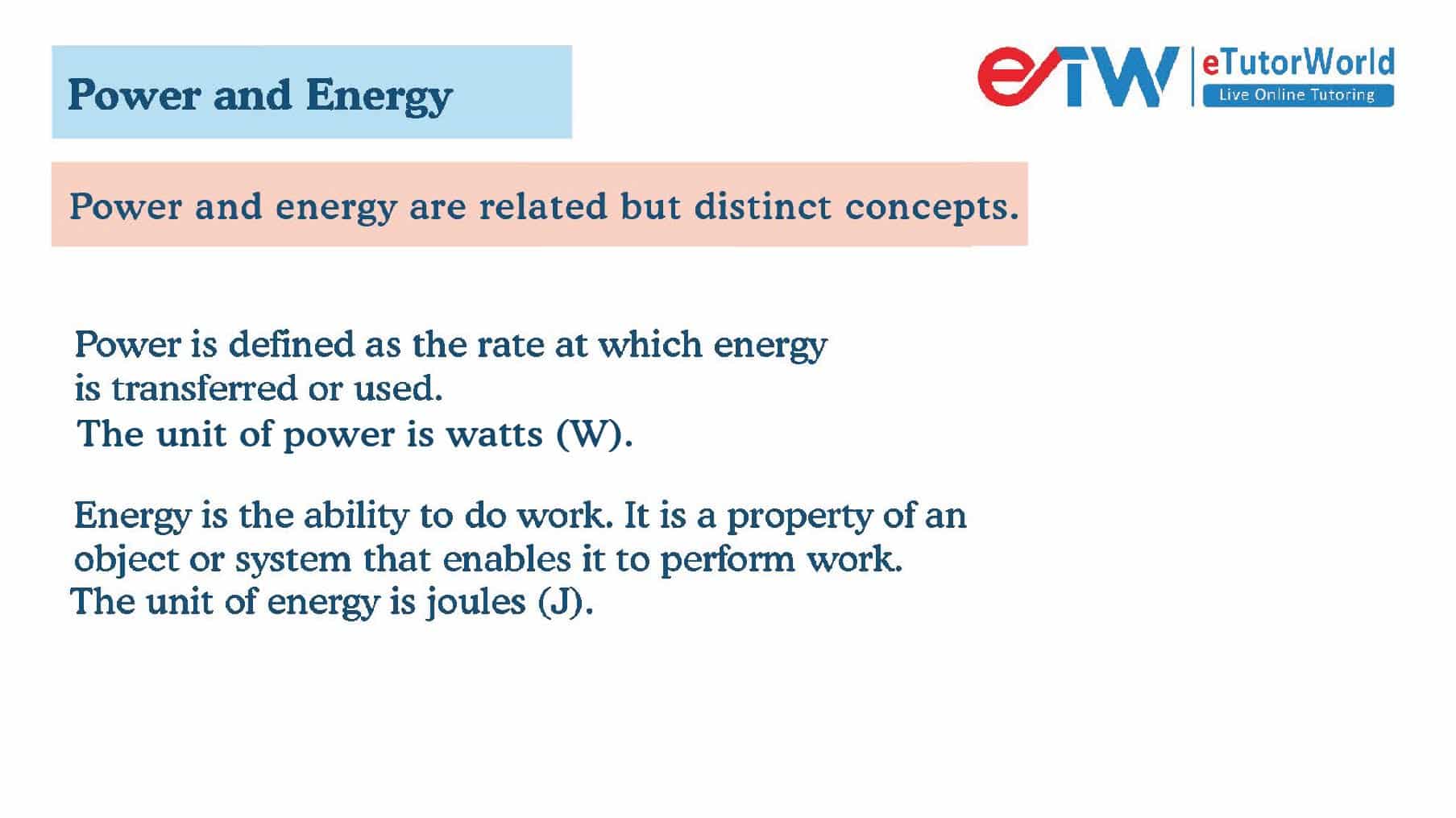Power and Energy
Grade 9 Science Worksheets
Power and energy are related but distinct concepts. In physics, power is defined as the rate at which energy is transferred or used.
Table of Contents:
- Power & Energy
- Difference between Power & energy
- Factors affecting Power & Energy
- Energy transformation into power
- Applications of Power & Energy
- FAQs
Power and Energy - Grade 9 Science Worksheet PDF
This is a free printable / downloadable PDF worksheet with practice problems and answers. You can also work on it online.
|
Untimed | |
Sign up with your email ID to access this free worksheet.
"We really love eTutorWorld!"
"We really love etutorworld!. Anand S and Pooja are excellent teachers and are quick to respond with requests to tutor on any math topic!" - Kieran Y (via TrustSpot.io)
"My daughter gets distracted easily"
"My daughter gets distracted very easily and Ms. Medini and other teachers were patient with her and redirected her back to the courses.
With the help of Etutorworld, my daughter has been now selected in the Gifted and Talented Program for the school district"
- Nivea Sharma (via TrustSpot.io)
Power & Energy
Power is the amount of energy transferred or used per unit of time. The unit of power is watts (W), which is equivalent to joules per second (J/s).
On the other hand, energy is the ability to do work. It is a property of an object or system that enables it to perform work. Energy can be stored or transferred from one form to another, but it cannot be created or destroyed. The unit of energy is joules (J).
The relationship between power and energy can be expressed mathematically as:
Energy = Power x Time
This equation shows that the amount of energy transferred or used is equal to the power multiplied by the time for which it is used. For example, if a 100-watt light bulb is turned on for 10 seconds, the energy used is:
Energy = Power x Time
Energy = 100 W x 10 s
Energy = 1000 J
Therefore, the relationship between power and energy is that power is the rate at which energy is transferred or used, and energy is the amount of work that can be done by a system or object.
Difference between Power & energy
Power and energy are two distinct concepts in physics, although they are often used interchangeably in everyday language. The main difference between power and energy is:
Energy is a measure of the capacity of a system to do work. It is a scalar quantity that is measured in joules (J). Energy can be stored in various forms, such as potential energy, kinetic energy, thermal energy, or chemical energy.
Power is a measure of the rate at which energy is transferred or used. It is a scalar quantity that is measured in watts (W), which are equivalent to joules per second (J/s). Power is the amount of energy that is transferred or used per unit of time.
To give an example, imagine a person lifting a weight. The energy required to lift the weight is the potential energy stored in the weight, which is proportional to its mass and height. The power required to lift the weight, on the other hand, is the rate at which the person is doing work, which is proportional to the force applied and the distance over which it is applied.
In summary, energy is a measure of the capacity to do work, while power is a measure of the rate at which work is done or energy is transferred. Understanding the difference between power and energy is important in many fields, including physics, engineering, and energy management.
Factors affecting Power & Energy
There are several factors that can affect the relationship between power and energy. Some of the main factors include:
Time: The longer a device or system operates at a certain power level, the more energy it will consume or transfer. Therefore, time is a critical factor in determining the total amount of energy used or transferred.
Power level: The higher the power level of a device or system, the more energy it will consume or transfer in a given amount of time. Therefore, power level is a critical factor in determining the rate of energy consumption or transfer.
Efficiency: The efficiency of a device or system determines how much of the input power is converted into useful output power. A less efficient system will require more input power to achieve the same output power, resulting in greater energy consumption.
Load: The type and amount of load on a system can affect the power and energy relationship. For example, a motor that is driving a heavy load will require more power to maintain the same speed, resulting in greater energy consumption.
Operating conditions: Environmental conditions, such as temperature and humidity, can affect the efficiency of a device or system and therefore affect the power and energy relationship.
Overall, the relationship between power and energy is complex and depends on a variety of factors. By understanding these factors, it is possible to optimize power usage and energy transfer to achieve maximum efficiency and minimize waste.

“There have been times when we booked them last minute, but the teachers have been extremely well-prepared and the help desk at etutorworld is very prompt.
Our kid is doing much better with a higher score.”
9th Grade Tutoring
eTutorWorld offers Personalized Online Tutoring for Math, Science, English, and Standardised Tests.
Our Tutoring Packs start at just under $21 per hour, and come with a moneyback guarantee.
Schedule a FREE Trial Session, and experience quality tutoring for yourself. (No credit card required.)
Energy transformation into power
Energy and power are related concepts, but they represent different aspects of the same physical phenomenon. Energy is the capacity to do work, while power is the rate at which work is done or energy is transferred. Therefore, energy can be transformed into power, and vice versa, through a process called energy conversion.
The process of energy conversion depends on the specific forms of energy involved. For example:
In electrical systems, energy can be converted into power through devices such as generators or batteries. A generator converts mechanical energy into electrical power, while a battery converts chemical energy into electrical power.
In mechanical systems, energy can be converted into power through devices such as motors or turbines. A motor converts electrical energy into mechanical power, while a turbine converts fluid energy (such as steam or water) into mechanical power.
In thermal systems, energy can be converted into power through devices such as engines or heat exchangers. An engine converts thermal energy into mechanical power, while a heat exchanger converts thermal energy from one fluid to another.
In each case, the energy is converted into power by a device that takes advantage of a natural or artificial process that can transform one form of energy into another.
Conversely, power can be transformed into energy by integrating the power over a period of time. For example, the energy consumed by an electrical appliance can be calculated by multiplying the power consumption (in watts) by the time (in hours) it is used. Therefore, the total energy used is equal to the power multiplied by the time.
In summary, energy can be transformed into power and vice versa through a variety of physical processes that depend on the specific forms of energy involved. Understanding these processes is essential for optimizing energy conversion and efficiency in various fields, such as engineering, physics, and energy management.
Applications of Power & Energy
Energy and power are fundamental concepts in physics and have many practical applications across a wide range of fields. Here are some of the common applications of energy and power:
Electrical systems: Energy and power are used extensively in electrical systems, including power generation, transmission, and distribution. Electrical power is used in homes, industries, transportation, and communication systems.
Mechanical systems: Energy and power are used in mechanical systems, including engines, motors, turbines, and pumps. Mechanical power is used in transportation, manufacturing, and construction.
Thermal systems: Energy and power are used in thermal systems, including heating, cooling, and refrigeration. Thermal power is used in homes, industries, and transportation.
Renewable energy: Energy and power are used in renewable energy systems, including solar, wind, and hydroelectric power. Renewable energy sources are becoming increasingly popular due to their environmental benefits and long-term cost savings.
Space exploration: Energy and power are essential for space exploration, including the generation of electrical power for spacecraft, communication systems, and life support systems.
Medical applications: Energy and power are used in medical applications, including diagnostic imaging equipment, such as X-ray machines and CT scanners, as well as medical lasers for surgery and treatment.
Research and development: Energy and power are used in research and development, including testing and evaluation of new technologies, such as batteries, fuel cells, and renewable energy systems.
Overall, energy and power are used in countless applications across a wide range of fields. Understanding the principles of energy and power is essential for designing and optimizing systems that use or generate energy and power, as well as for managing energy resources efficiently and sustainably.

Do You Stack Up Against the Best?
If you have 30 minutes, try our free diagnostics test and assess your skills.
Power and Energy FAQS
Why are energy and power important in electrical systems?
Energy and power are important in electrical systems because they determine the amount of electrical energy that can be generated, transmitted, and used. Understanding the principles of energy and power is essential for optimizing the efficiency of electrical systems and reducing energy consumption and costs.
How are energy and power used in renewable energy systems?
Energy and power are used in renewable energy systems to capture and convert natural sources of energy, such as solar, wind, and hydroelectric power, into usable forms of electrical or mechanical power. Renewable energy systems are becoming increasingly important as society looks to reduce reliance on fossil fuels and mitigate the impacts of climate change.
How are energy and power used in space exploration?
Energy and power are essential for space exploration because spacecraft require power to operate communication systems, life support systems, and scientific instruments. Spacecraft use a variety of power sources, including solar panels, batteries, and fuel cells, to generate electrical power and store energy for use during missions.
How are energy and power used in medical applications?
Energy and power are used in medical applications to diagnose and treat various medical conditions. Medical devices, such as X-ray machines, CT scanners, and medical lasers, use energy and power to generate diagnostic images and perform surgical procedures.
Why is research and development important for energy and power applications?
Research and development is important for energy and power applications because it helps to advance the state of the art in energy generation, transmission, and storage. Advances in energy and power technologies have the potential to transform many industries and improve the quality of life for people around the world.

Kathleen Currence is one of the founders of eTutorWorld. Previously a middle school principal in Kansas City School District, she has an MA in Education from the University of Dayton, Ohio. She is a prolific writer, and likes to explain Science topics in student-friendly language. LinkedIn Profile
Affordable Tutoring Now Starts at Just $22.49
eTutorWorld offers affordable one-on-one live tutoring over the web for Grades K-12. We are also a leading provider of Test Prep help for Standardized Tests (SCAT, CogAT, MAP, SSAT, SAT, ACT, ISEE, and AP).
What makes eTutorWorld stand apart are: flexibility in lesson scheduling, quality of hand-picked tutors, assignment of tutors based on academic counseling and diagnostic tests of each student, and our 100% money-back guarantee.
Whether you have never tried personalized online tutoring before or are looking for better tutors and flexibility at an affordable price point, schedule a FREE TRIAL Session with us today.
*There is no purchase obligation or credit card requirement
IN THE NEWS

Our mission is to provide high quality online tutoring services, using state of the art Internet technology, to school students worldwide.
Online test prep and practice
SCAT
SSAT
ISEE
PSAT
SAT
ACT
AP Exam
Science Tutoring
Physics Tutoring
Chemistry Tutoring
Biology Tutoring
Math Tutoring
Pre-Algebra Tutoring
Algebra Tutoring
Pre Calculus Tutoring
Calculus Tutoring
Geometry Tutoring
Trigonometry Tutoring
Statistics Tutoring
Quick links
Free Worksheets
Fact sheet
Sales Partner Opportunities
Parents
Passive Fundraising
Virtual Fundraising
Our Expert Tutors
Safe and Secure Tutoring
Interactive Online Tutoring
After School Tutoring
Elementary School Tutoring
Middle School Tutoring
High School Tutoring
Home Work Help
Math Tutors New York City
Press
©2022 eTutorWorld Terms of use Privacy Policy Site by Little Red Bird
©2022 eTutorWorld
Terms of use
Privacy Policy
Site by Little Red Bird











